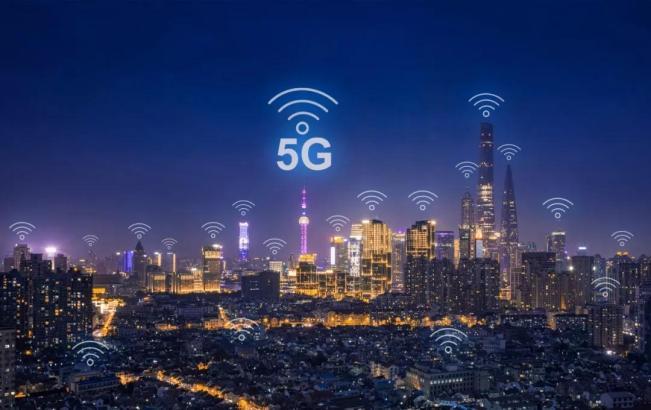The frequently searched 5G will really "break the circle" in 2021!

At the end of 2021, it has been two years since the issuance of 5G licenses. In more than two years, 5G has developed really fast. In addition to 5G mobile phones that consumers have a deeper experience, it is in the parks and computer rooms of major financial, energy, medical and other industries. , 5G is also appearing more and more. In the goal of empowering thousands of industries, the development of 5G has always been consistent with one million base stations, tens of thousands of industry applications, 400 million 5G terminals... these brilliant transcripts are excellent answers to the initial 5G construction plan.
In response to the new requirements set forth in the "Fourteenth Five-Year Plan for the Development of Information and Communication Industry", the depth and breadth of 5G construction will continue to expand. It is expected that by 2025, the 5G world we will see will be beyond imagination.
The number of base stations breaks one million, and the number of terminal connections breaks 400 million
Build roads first, then open to traffic, moderately ahead of time, in order to promote the use of construction. In 2021, 5G network construction will closely follow industry and market needs, and achieve deep coverage and on-demand coverage. As of October 2021, the number of 5G base stations in China has reached 1.159 million, and the number of 5G terminal connections has reached 450 million. The gigabit optical network has the capacity to cover more than 200 million households, and has built the world's largest 5GSA network.
Most of the opportunities in the 5G government-enterprise market depend on the large-scale deployment of 5G independent networking (5GSA). This enables industrial applications requiring specific security and/or performance to take full advantage of 5G, such as ultra-reliable, low-latency (URLLC), network slicing, and edge computing technologies. The latest GSMA research shows that China is the only country in the global market where all operators have deployed 5GSA networks. It is expected that in 2022, focusing on the further development of 5GSA, China will become a pioneer market, and operators will have the potential to provide strong private and private networks.
The construction of 5G network will continue to advance by leaps and bounds. In the "Fourteenth Five-Year Plan for the Development of Information and Communication Industry" issued by the Ministry of Industry and Information Technology in November, the main indicators for the development of the information and communication industry during the "14th Five-Year Plan" period were also formulated. In terms of 5G base stations, it is required to have 26 5G base stations per 10,000 people by 2025, which means that by 2025, the number of 5G base stations in China will reach more than 3.6 million. In the next four years, China will build at least 2.445 million 5G base stations, and it is estimated that 600,000 5G base stations will be added every year. The 5G network will gradually cover the whole country. Data from the GSMA think tank predicts that by the end of 2022, China will have 640 million 5G connections, of which 5G will account for nearly 40% of the country's total mobile connections.
Consumers' 5G experience is getting better and better
Previously, promotion on the toC side encountered the problem that consumers did not understand or accept it, but now it can be seen from the increase in the number of 5G package users that consumers are also voting for 5G with their own choices.
As of October, China Telecom’s 5G package users reached 168 million, a net increase of 12.95 million that month; China Mobile’s 5G package customers totaled 356 million, a net increase of 24.299 million from the previous month; China Unicom’s total 5G package users were 1.44 Billion, the net new users of the 5G package that month were 6.568 million. The total number of 5G users of the three major operators has exceeded 668 million.
Domestic 5G mobile phone shipments have gradually increased. According to data from China Academy of Information and Communications Technology, from January to August 2021, 5G mobile phone shipments in the Chinese market were 168 million units, a year-on-year increase of 79.7%, accounting for 74.1% of mobile phone shipments in the same period.
Although the government and enterprise markets are often touted as the "blue ocean" in the 5G era, Chinese operators have not ignored the new growth in the consumer sector. The latest GSMA report points out that operators’ efforts to migrate customers to 5G packages appear to be having a positive financial impact. Driven by the penetration rate of 5G, China Unicom’s mobile business ARPU (average revenue per user) increased by 8.5% year-on-year in the first half of 2021, while China Telecom and China Mobile both stated that 5GARPU increased by 10% over 4G, bringing this to the mobile industry. hope.
As one of the important applications on the consumer side, the emergence of 5G news has attracted huge attention. Last year, the three major operators jointly released the "5G Message White Paper" to plan commercial use of 5G messages. After more than a year, China Unicom recently announced the launch of 5G message trial commercialization across the country and launched the "5G Message Experience Recruitment Campaign" for corporate customers and individuals Users provide free 5G message experience package, friendly experience users will enjoy a richer, more convenient, smart and safe new 5G message experience. Industry insiders believe that with the large-scale commercial use of 5G, the increase in the penetration rate of smart terminals, and the development of digital and payment technologies, 5G news will usher in huge market opportunities. By then, the scene power of trillions of short messages will be unstoppable, and RCS (Converged Communication) is expected to become the main entrance for future smart terminal scene services.
Set sail to lead the continuous expansion of toB applications
Since the beginning of this year, 5G applications have blossomed everywhere, and the industry has expanded rapidly. At present, there are more than 10,000 cases of 5G application innovation across the country, covering 22 important industries in the national economy. Industrial manufacturing, mining, ports, and other vertical industry application scenarios have accelerated their scale implementation. The initial production auxiliary business has been expanded to core businesses such as equipment control and quality control. It is a relatively mature field of current 5G application solutions. Han Xia, chief engineer of the Ministry of Industry and Information Technology, said that the important role of 5G and Industrial Internet in supporting the real economy to reduce costs, improve quality and efficiency, and green development continues to appear. In July of this year, the Ministry of Industry and Information Technology organized the implementation of the "Dual Gigabit" network coordinated development action and the 5G application "Sailing" action to promote the coordinated development of 5G and Gigabit optical networks. Accelerate the expansion of industrial Internet and 5G integration and innovative applications in key industries of the national economy, select industrial Internet industry demonstration bases, publish reference guides for the integration of industrial Internet and steel industry, more than 1,800 "5G + Industrial Internet" projects under construction nationwide, the fourth The "Blooming Cup" contest has more than 12,000 application cases. On November 22, the Ministry of Industry and Information Technology released the second batch of typical application scenarios and key industry practices of "5G+Industrial Internet", such as smart tally in factories, global logistics monitoring, virtual on-site services, and enterprise collaboration... These are becoming typical application scenarios in Vietnam. More and more production and manufacturing links have been promoted. At present, there are still many problems that need to be solved in the distance of 5G application from "model house" to "commercial house". Chen Yami, the 5G intelligent logistics architect of JD Logistics, said that in practice, it has been found that 5G still has service capabilities, costs, integrated solutions, integrated products and other issues. 5G "ToB" needs to be more standard and composable. The ability of standards to meet industry needs. Li Bangyu, deputy chief engineer of the Central Research Institute of Siasun Robot Automation Co., Ltd., also mentioned the cost issue. Because the profit margin of the manufacturing industry is relatively low, the requirements for the cost of manufacturing equipment are still relatively strict. 5G equipment, 5G modules, CPE or firmware networks, and 5G tariffs are all areas of focus for enterprises. The application of 5G in vertical industries cannot bypass the issue of fiber replacement. Zhuang Kan, Technical Director of Hisense Group, said that Hisense uses the flexibility, low latency, and high-throughput network slicing of 5G networking to meet the rigid needs of the industry for reliable performance and safety. However, the scope of 5G applications is limited, and it is basically used in some mobile scenarios-AGV, warehousing, flexible pipelines, etc. But in some fixed scenes, it is not as convenient as wired. At the same time, there are many inconveniences in use. "Opening the IoT card" and troubleshooting are time-consuming and laborious. In this regard, Du Jiadao, deputy director of the 5G Application Innovation Center of China Academy of Information and Communications Technology, and chairman of the 5G industry phalanx industry application group, said that the problems faced in 5G applications can be roughly divided into "application side, network side, and public burden side." In the future, the first step is to strengthen the establishment of scenarios on the "application side", and some cross-border cooperation mechanisms are needed to ensure the development and implementation of business solutions. Secondly, in terms of cost, a customized or submerged service model is required, which will promote the transformation of the entire 5G network from "ToC" to "ToB". The first is to realize that the existing 5G network must be integrated with the existing systems of the industry to achieve seamless connection and achieve plug-and-play. Second, it is necessary to provide for industry-oriented services and end-to-end guarantees for 5G networks. Third, solve the problem of equipment cost, and make customized and lightweight transformation of equipment. Fourth, to reduce terminal costs, a lot of work needs to be done in modules, chips, etc., to solve the problems of customization, high cost, and high R&D. With the joint efforts of all parties, the application scenarios of 5G have been continuously sorted and summarized, and 5G has gradually penetrated into thousands of industries. Facing the future, the "Fourteenth Five-Year Plan for the Development of the Information and Communication Industry" pointed out that it is necessary to promote the accelerated transformation of 5G applications to industrialization and scale. 5G converged applications are an important engine to promote the digital, networked, and intelligent transformation of the economy and society. During the "14th Five-Year Plan" period, for the three major areas of information consumption, real economy, and people's livelihood services, the Ministry of Industry and Information Technology will work with relevant ministries and local governments to focus on promoting 5G applications in 15 industries, creating a new ecosystem of in-depth integration, and realizing the depth and breadth of 5G applications in key areas Double breakthroughs, the construction of the dual pillars of the technology industry and the standard system, and gradually form a development situation where 5G applications "set sail". Therefore, facing the future development of 5G, the industry must set up a "team competition" for 5G application development, where all parties complement each other's advantages and work together to open up all aspects of technology, standards, products, and solutions. Strengthen cross-departmental, cross-industry, cross-field alliances and industry associations to carry out extensive industry collaboration and docking cooperation, and create a cross-industry synergy "big ecosystem". Today, my country has adopted 5G development as a national strategy and as one of the broader goals of digital transformation and improving the competitiveness of the international economy. Therefore, as the industry rapidly integrates next-generation communication technologies to support key economic sectors such as manufacturing, healthcare, and transportation, 5G will help China's various industries in different ways.